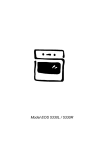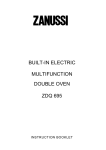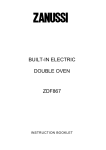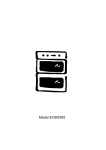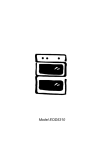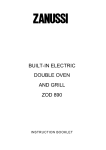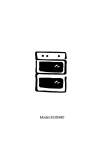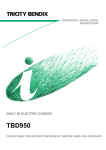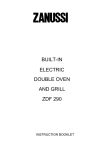Download Electrolux EOB 31010 Specifications
Transcript
Model EOB 948/949 TECHNICAL DETAILS MODEL NO. EOB 948/949 Voltage: 230-240 Volts AC 50Hz Wattage: 2.4-2.6kW Height: 595mm Width: 595mm Depth: 545mm (excluding handles and knobs) Weight: 39kg This appliance complies with: European Council Directive 73/23/EEC. EMC Directive 89/336/EEC. CE Marking Directive 93/68/EEC. 2 CONTENTS Technical Details ................................................................................................................................... 2 Contents .................................................................................................................................................. 3 Safety ....................................................................................................................................................... Before Installation ........................................................................................................................... During Operation ............................................................................................................................. After Use ......................................................................................................................................... General ........................................................................................................................................... 5 5 5 6 6 Installation Instructions ......................................................................................................................... Things You Need to Know .............................................................................................................. Warnings ......................................................................................................................................... Things to Note ................................................................................................................................. 7 7 7 7 Getting Things Ready ............................................................................................................................ 7 Choice of Electrical Connection ...................................................................................................... 7 Preparing Cabinet for Fitting Oven ................................................................................................. 8 Recommended Cabinet Dimensions .............................................................................................. 9 How to Finish Unpacking ................................................................................................................ 10 Tools Required ................................................................................................................................ 10 Making the Electrical Connections ....................................................................................................... 10 Preparing Cable .............................................................................................................................. 10 To Remove Cover of Mains Terminal ............................................................................................. 10 Connecting to the Mains Terminal .................................................................................................. 11 Connecting to a Hob or Cooker Point ............................................................................................. 11 Checking Electrical Connections .................................................................................................... 11 Fitting Into The Cabinet ......................................................................................................................... 12 Introduction ............................................................................................................................................. Getting to Know Your Oven ............................................................................................................ Rating Plate .................................................................................................................................... General Notes on Using the Oven .................................................................................................. About Condensation and Steam ..................................................................................................... Cookware ........................................................................................................................................ The Cooling Fan for the Controls .................................................................................................... Control Panel Indicator Neon .......................................................................................................... Grill and Oven Furniture .................................................................................................................. 13 13 14 14 14 14 14 14 15 The Oven Timer ...................................................................................................................................... 16 The Grill ................................................................................................................................................... 18 Uses of the Grill .............................................................................................................................. 18 The Telescopic Runners ................................................................................................................. 18 Selecting the Grill ............................................................................................................................ 18 Things to Note ................................................................................................................................. 18 Fitting the Shelf ............................................................................................................................... 18 The Grill Pan and Handle ............................................................................................................... 19 Hints and Tips ................................................................................................................................. 19 3 CONTENTS The Fan Oven .......................................................................................................................................... 20 Uses of the Fan Oven ..................................................................................................................... 20 Selecting the Fan Oven .................................................................................................................. 20 Things to Note ................................................................................................................................. 20 To Fit the Oven Shelves ................................................................................................................. 20 Hints and Tips ................................................................................................................................. 21 Oven Cooking Chart ....................................................................................................................... 22 Roasting Chart ................................................................................................................................. 23 Thermal Grilling ...................................................................................................................................... 24 Uses of Thermal Grilling ................................................................................................................. 24 Selecting Thermal Grilling ............................................................................................................... 24 Things to Note ................................................................................................................................. 24 Hints and Tips ................................................................................................................................. 25 Thermal Grilling Chart ..................................................................................................................... 25 Defrost Feature ....................................................................................................................................... 26 Uses of Defrost Feature .................................................................................................................. 26 Selecting Defrost ............................................................................................................................. 26 Things to Note ................................................................................................................................. 26 Hints and Tips ................................................................................................................................. 26 Helpful Hints when Buying and Preparing Food ................................................................................. 27 Care and Cleaning .................................................................................................................................. 28 Cleaning Materials .......................................................................................................................... 28 Cleaning the Outside of the Appliance ........................................................................................... 28 Cleaning Inside the Oven/Grill ........................................................................................................ 28 Removing and Replacing Wirework Side Runners ......................................................................... 28 Cleaning the Grill and Oven Furniture ............................................................................................ 29 Care of Stayclean Surfaces ............................................................................................................. 29 Hints and Tips .................................................................................................................................. 29 Cooking to Reduce Soilage ............................................................................................................. 29 Cleaning the Door Glass.................................................................................................................. 29 Cleaning between the Outer and Inner Door Glass......................................................................... 30 To Remove the Outer Glass ........................................................................................................... 30 To Replace the Outer Glass ........................................................................................................... 30 To Clean the Inner Glass Door Panels ........................................................................................... 30 Replacing the Oven Light Bulb ....................................................................................................... 30 Something Not Working? ...................................................................................................................... 31 Service and Spare Parts ........................................................................................................................ 32 Guarantee Conditions ............................................................................................................................ 33 Notes ........................................................................................................................................................ 34 4 SAFETY DURING OPERATION THESE WARNINGS ARE PROVIDED IN THE INTERESTS OF YOUR SAFETY. ENSURE THAT YOU UNDERSTAND THEM ALL BEFORE INSTALLING OR USING THE APPLIANCE. This appliance is not intended to be operated by means of an external timer or separate remote control system Do not use this appliance if it is in contact with water. Never operate it with wet hands. PLEASE READ CAREFULLY This appliance is designed to be operated by adults. Young children must not be allowed to tamper with the appliance or play with the controls. BEFORE INSTALLATION During use the appliance becomes hot. Care should be taken to avoid touching the heating elements inside the oven. This appliance is heavy and care must be taken when moving it. CAUTION: Accessible parts may be hot when the grill is in use. Young children should be kept away. Ensure that all packaging, both inside and outside the appliance has been removed before the appliance is used. Take great care when heating fats and oils, as they will ignite if they become too hot. Do not try to lift or move the appliance by pulling the door handles. Refer to installation instructions. This appliance has been designed for cooking edible foodstuffs only, and must not be used for any other purposes. The appliance must be installed according to the instructions supplied. Any electrical installation work must be undertaken by a qualified electrician or competent person. Never place plastic or any other material which may melt in the oven. It is dangerous to alter or modify the specifications of the appliance in any way. Take care to follow the recommendations given for tending the food when grilling. Use the handle provided in the recommended way. Ensure cooking utensils are large enough to contain foods to prevent spillages and boil overs. Do not allow young children to play with any part of the packaging. Always use oven gloves to remove and replace food in the oven. After installation, please dispose of the packaging with due regard to safety and the environment, your local authority can arrange this. 5 Do not leave utensils containing foodstuffs, e.g. fat or oil in or on the appliance in case it is inadvertently switched ON. Ensure that you support the grill pan when it is in the withdrawn or partially withdrawn position. Ensure that all vents are left unobstructed to ensure ventilation of the oven cavity. Cookers and hobs become very hot, and retain their heat for a long period of time after use. Children should be kept well away from the appliance until it has cooled. Ensure the anti-tilt shelves are put in place correctly. Refer to instructions on page 21. Never line any part of the appliance with foil. Do not allow heatproof cooking material, e.g. roasting bags, to come into contact with oven elements. GENERAL Under no circumstances should any repairs be carried out by an inexperienced person as this may cause injury or serious malfunction. Always stand back from the appliance when opening the oven door to allow any build up of steam or heat to release. This appliance should be serviced by an authorised service Engineer and only genuine-approved spare parts should be used. Stand clear when opening the drop down oven door. Do not allow it to fall open - support it using the door handle, until it is fully open. Do not stand on the appliance or on the open oven door. Never leave the appliance unattended when the oven door is open. Do not hang towels, dishcloths or clothes from the appliance or its handle. They are a safety hazard. Do not place sealed cans or aerosols inside the oven. They may explode if they are heated. Always allow the cooling fan to cool the appliance down before switching off at the wall prior to carrying out any cleaning or maintenance work. AFTER USE Only clean this appliance in accordance with the instructions given in this book. Ensure that all control knobs are in the OFF position when not in use. For hygiene and safety reasons this appliance should be kept clean at all times. A build-up of fats or other foodstuffs could result in a fire, especially in the grill pan. Your safety is of paramount importance. Therefore, if you are unsure about any of the meanings of these WARNINGS contact the: Customer Care Department Telephone 0870 5 950950 6 INSTALLATION INSTRUCTIONS THINGS YOU NEED TO KNOW GETTING THINGS READY WARNINGS: · This appliance must be installed by a qualified electrician/competent person. Safety may be impaired if installation is not carried out in accordance with these instructions. CHOICE OF ELECTRICAL CONNECTION · This appliance must be earthed. · Do not remove the screws from the earth tab extending from the oven mains terminal block (Fig. 8). · Before connecting the appliance make sure that the voltage of your electricity supply is the same as that indicated on the rating plate. This is situated on the front frame of the appliance and can be seen upon opening the door. a) It is recommended that this appliance is wired with suitably rating cable (min 13 A), into fixed wiring using a double pole isolator with a least 3mm contact separation in all poles and neutral, located within 2m of the appliance. If this fixed wiring circuit is only supplying the appliance, then a fuse of 13A (or circuit breaker) should be incorporated. When the circuit combines oven and hob, then wire and fuse fuse rating should be increased accordingly. · Do not alter the electrical circuitry of this appliance. · There are two possible ways to connect your appliance. Please choose from the most appropriate after reading the descriptions. Subject to Regional Electricity Companies regulations if you wish to connect the oven and hob to the power supply you may use one of the following two methods:- THINGS TO NOTE · This appliance is designed to be fitted in cabinets of the recommended dimensions as shown (Fig.3 and 4) without any modification to the cabinet. · If your cabinet interior dimension is between 565570mm the oven may still be fitted. However, a minor modification to the cabinet will be required. · The dimensions given provide adequate air circulation around the unit within the cabinet, ensuring compliance with BS EN60-335. · Enquiries regarding the installation of the cooker point, if required, should be made to your Regional Electricity Company to ensure compliance with their regulations. · The appliance socket switch should be outside the cabinet but within 2m of the appliance to make it accessible to switch off the appliance in case of an emergency. · To protect the hands, wear gloves when lifting the oven into its housing. b) If you wish to connect an oven and a hob to a cooker point you can:i. By connecting the appliance and hob separately to the cooker point. Oven and hob units should be separately connected to a control panel. In this case the appliance should be operated from 6mm² twin core, and earth, PVC insulated multicore cable. See Fig.1. Fig. 1 NOTE: HOUSE CIRCUIT Earth leakage and continuity tests must be carried out before the appliance is connected to the mains supply and re-checked after fitting. 7 II. By connecting the cooker point to the hob and then connecting the hob to the oven. Provided that the hob manufacturer permits it, connect the oven to the hob to the cooker point using the same cabling as described in (a) above. Check the hob terminal block is large enough to take two cables and is of suitable rating. If not b) i) on page 7 must be used. See Fig.2. NOTE: 13 amp cable is not suitable for connecting this application. Fig. 2 NOTE: It is good practice to: · Fit an Earth Leakage Circuit Breaker to your house wiring · Wire your appliance to the latest IEE regulations. PREPARING CABINET FOR FITTING OF OVEN · Make sure the cabinet is the correct size for the appliance to be fitted (Ref. Fig. 3 and 4). · If the size is between 565-570mm, then the cabinet should be modified so that at the screw fixing points the recommended dimension of at least 560-565mm is maintained. The modification should ideally be localised to ensure that after screw fitment the oven is securely fixed into position. · The cabinet must be stable and level by firmly securing it to the wall or floor. If necessary, make arrangements to ensure the shelf upon which the oven will rest is level. 8 RECOMMENDED CABINET DIMENSIONS (IN MILLIMETRES) Fig.3 Built Under Installation 600 560 min 570 max 600 595 5 585 600 min Cross section through cabinet showing oven positioned 200 Recommended 540 540 5 5 595 570 5 5 Cross section through cabinet showing oven positioned 570 550 min 560 min 570 max 550 min Fig.4 Built In Installation 9 HOW TO FINISH UNPACKING · Place appliance next to the cabinet in which it will be installed. · Remove the appliance packing except for bottom tray which should be left in position until the appliance is ready to be fitted into its cabinet. Carefully score down from each of the cable sheathing along the length of the bare earth wire (if a cut was made along the length of the live or neutral wires, it might cut into their sheathing) to the cuts already made. · Carefully prise open the sheathing at each end of the cable to expose the encased wiring. TO REMOVE COVER OF MAINS TERMINAL NOTE: It is imperative that the appliance is left in the base to protect both the appliance and the floor. · · From the rear of the appliance, remove mains input terminal cover to gain access to terminal block. Ensure the owner is given these operating instructions. · TOOLS REQUIRED First remove retaining screw with pozidrive screwdriver. See Fig. 5. The following tools will be needed and it helps to assemble them before starting to install your oven: A terminal screwdriver (3mm wide blade) A pozidrive screwdriver Pliers Wirestrippers Knife Sidecutters Adhesive tape Tape Measure Fig. 5 MAKING THE ELECTRICAL CONNECTIONS · Prise cover loose using screwdriver in position (1) then lever off with screwdriver in position (2) at either side. See Fig. 6. Important: Switch off at mains, miniature circuit beaker and if appropriate, remove fuse before commencing any electrical work. PREPARING CABLE We recommend you use a new length of cable to ensure your safety. · · Ensure you have the correct length of cable appropriate to the wiring method you are using. When fitting new cable allow sufficient cable for removal of the unit at a later date, should it be necessary. Fig. 6 Score, but do not cut through, around the sheathing with a knife 100mm (4in) from each end of the cable and break through to the encased wires by bending the cable backwards and forwards to fatigue the sheathing. 10 · CONNECTING TO A HOB OR COOKER POINT Lift cover and remove screw from cable clamp. See Fig. 7. · Either follow in general terms the instructions for connecting to the terminal block or refer to the hob suppliers installation instructions. Feed the cable through the cabinet and arrange to route the cable away from the appliance which may become hot. CHECKING ELECTRICAL CONNECTIONS Fig.7 · Confirm the appliance is correctly connected by switching on and observing the various oven functions indicators. Warning: This appliance must be earthed. · The electronic timer will flash. · NOTE: HOUSE CIRCUIT CONNECTING TO MAINS TERMINAL Make connection as shown in Fig. 8 by proceeding as follows:- Earth leakage and continuity tests must be carried out before the appliance is connected to the mains supply and re-checked after fitting. Fig.8 · Preform wires to the appropriate shape to suit fitting into the mains terminal block. · Strip inner wirestrippers. · Twist the bared wires using pliers. · Cut bared wires 10mm away from the end of the inner insulation. Where uninsulated Earth wires are used ensure they are suitably sheathed to leave 10mm bare wire to fit into the terminal. · Clamp bare wires into the relevant terminal and check they are held by tugging each one in turn. · Clamp the mains cable securely ensuring 5mm of the outer insulation is inside the terminal block and that the wires are not taught but not so slack as to cause any fouling. See Fig. 8. · Place fuse/miniature circuit breaker in circuit and switch on at mains. insulation on wires using 11 FITTING INTO THE CABINET IMPORTANT: Ensure that the oven is switched off at the wall before any further work is carried out. · Using a tape measure establish the internal width of the cabinet. Refer to page 7 if greater than 565mm. · Position the appliance in front of the cabinet. See Fig. 9. · Take out all oven furniture before installation to reduce the weight you need to lift. The oven door should be taped up to keep it closed whilst lifting. · To place the appliance into the cabinetry follow the procedure below: · N.B. Two people will be required to carry out the lifting procedure. Fig. 9 a) Each person should squat either side of the appliance. b) Tilt the appliance so that your hands can support the underside of the appliance. Warning: Do not attempt to lift this appliance by the handles. c) Keeping your back straight, raise the appliance to the cabinet by straightening at the knees. d) Rest the rear underside of the appliance on the cabinet floor while your hands support the front. e) The appliance can be pushed fully into the cabinet. Take care to avoid fouling the mains lead. f) Ensure the appliance is central in the cabinet and level. g) When the appliance is fully housed, screw the stability screws (supplied with the appliance) into the side of the cabinet taking care not to distort the side trims (See Fig 10). It is advisable to turn each screw alternatively to avoid damaging the trims. Fig. 10 h) Switch on the appliance then refer to the operating instructions in the following pages. 12 INTRODUCTION WARNING: THIS APPLIANCE MUST BE EARTHED GETTING TO KNOW YOUR OVEN B A A - Function Selector Fan Oven Full Grill Thermal Grill B - Automatic Timer C - Fan Oven / Grill Control D - Oven / Grill Indicator Neon 13 C D RATING PLATE THE COOLING CONTROLS This is situated on the lower front frame of the appliance and can be seen upon opening the door. Alternatively the rating plate may also be found on the back or top of some models (where applicable). FAN FOR THE The cooling fan comes on immediately when the grill is switched on and after a short time when the oven is in use. The appliance must be protected by a suitably rated fuse or circuit breaker. The rating of the appliance is given on the rating plate. During the initial period the cooling fan may turn ON and OFF, this is quite normal. Do not switch off the appliance at its power point before the cooling fan has cooled the appliance down. Do not remove the rating plate from the appliance as this may invalidate the guarantee. CONTROL PANEL INDICATOR NEON GENERAL NOTES ON USING YOUR OVEN The light indicates whether the grill or oven is switched ON. In the case of the oven, the neon also indicates when the set temperature has been reached. We suggest that you run the oven elements for 10 – o 15 minutes at 220 C to burn off any residue from their surfaces. The procedure should be repeated with the grill for approximately 5 – 10 minutes. During this period an odour may be emitted, it is therefore advisable to open a window for ventilation. If the neon does not operate as the instructions indicate the controls have been incorrectly set. Return all controls to zero and re-set following the instructions for the required setting. ABOUT CONDENSATION AND STEAM When food is heated it produces steam in the same way as a boiling kettle does. The oven is vented to allow some of this steam to escape. However, always stand back from the appliance when opening the oven door to allow any build up of steam or heat to release. If the steam comes into contact with a cool surface on the outside of the appliance, e.g. a trim, it will condense and produce water droplets. This is quite normal and is not caused by a fault on the appliance. To prevent discolouration, regularly wipe away condensation and also soilage from surfaces. COOKWARE Baking trays, oven dishes etc., should not be placed directly against the grid covering the fan at the back of the oven. Do not use baking trays larger than 30cm x 35cm (12” x 14”) as they will restrict the circulation of heat and may affect performance. 14 GRILL AND OVEN FURNITURE The following items of oven furniture have been supplied with the appliance. If you require replacements of any of the items listed below please contact your local Service Force Centre, quoting the relevant part number. 1 grill pan (311409401) 1 grill pan handle (311468100) NOTE If you require an additional handle for your grill pan, this can be ordered from your local Service Force Centre by quoting part number 311479800\6. 1 grill pan grid (311419801) 2 cranked shelves Scuffing of the Stayclean panel/s by the oven furniture pack may occur during transit. These marks will disappear after the oven elements have been burnt off for the first time. 15 THE OVEN TIMER Cookpot symbol Please note that this is a 24 hour clock, for example 2.00 pm is shown as 1400. Bell symbol In the following pages we explain how to set the controls. Read through them a few times until you are familiar with the procedure. If the oven is switched off on the wall, or there is a loss of power, the clock will stop and you will not be able to use the fan oven. When you first switch the electricity supply on, the timer display will flash. Selector TO SET THE TIME OF DAY Turn the selector knob to 'Manual' then turn to 'Time Setting'. Set the correct time by turning and holding the setting knob clockwise. Adjust the time by turning the setting knob in either direction. Turn the selector knob back to 'Manual'. TO USE THE COUNTDOWN Turn the selector knob to ‘Countdown’. Turn the setting knob clockwise until the display shows the time you want. The bell symbol ( ) will be showing and this will stay lit up during the time. Our diagram shows the timer set to 5 minutes. If you change your mind and want to cancel the time you have set, simply turn the setting knob anticlockwise. Then turn the selector to ‘Manual’. When you are using the 'Countdown' you can make the clock show the time of day by turning the selector knob to ‘Manual’. The bell symbol will stay on to remind you that the 'Countdown' is set. At the end of the timed period an alarm will sound and the bell symbol will go out. Switch off the alarm by turning the selector knob to ‘Time Setting’. Then turn to ‘Manual’ and the time of day will show in the display. Note: You can use the 'Countdown' when an automatic sequence has been set, as long as you remember the following point. 1. Turn the selector knob to ‘Automatic’ as soon as you have entered the timed period into the display. 16 Setting knob AUTOMATIC CONTROL When you use the automatic controls for the first time it’s probably best to choose a time when you are at home. That way you can check to make sure you’ve set everything correctly and you’ll feel much more confident when you are away from home in the future. SETTING THE CONTROLS FOR AUTOMATIC USE This is very easy. All you have to do is work through the steps below. The clock will work out the rest for itself. 1. Is the electricity supply on? 2. Is the clock To adjust turn the selector knob showing the to ‘Manual’ then to ‘Time correct time? Setting’. Turn the setting knob in either direction. 3. How long Turn the selector knob to ‘Cook will the food Time’. Then turn the setting knob take to cook? until the length of time you want the food to cook shows in the display. The maximum cooking time is 10 hours. ‘Auto’ will show in the display. 4. What time do Turn the selector knob to ‘End you want the Time’. Turn the setting knob until the time the oven is to food to be switch off shows in the display. cooked by? The cookpot ( ) will go out. The ‘End Time’ must not be more than 23 hours 59 minutes from the time of day. For example if the time of day is 9.00 am the latest ‘End Time’ will be 8.59 am the next day. 5. Set to Turn the selector knob to automatic. ‘Automatic’. 6. Turn on the Turn the oven control to the oven control. required temperature. The time shown on the right gives an example of setting the automatic controls when the time is 9.00 am, the food is to be cooked for 2½ hours and the food is needed at 6.00 pm (1800 hours). The clock will work out what time the oven will switch itself on and it will turn the oven off at the end. Once the automatic sequence is finished there will be an alarm to remind you that you need to set the oven for manual operation. To do this turn the selector knob to ‘Manual’. Turn off the oven control and function selector. If you change your mind and want to cancel a programme that you have set simply turn to ‘Time Setting’ and then to ‘Manual’. 17 THE GRILL USES OF THE GRILL CAUTION – ACCESSIBLE PARTS MAY BECOME HOT WHEN THE GRILL IS IN USE. CHILDREN SHOULD BE KEPT AWAY. Use the full heat grill only for foods which require high heat and short cooking times, e.g. toast, blue/rare steaks. Use thermal grilling to grill all other foods, e.g. bacon, chops, sausages, chicken joints, etc. See chart on page 25 for recommended cooking times, temperatures and shelf positions. THE TELESCOPIC RUNNERS The oven is fitted with a telescopic runner system in the top shelf position. The runners allow the shelf to be pulled out when tending food for easier access. SELECTING THE GRILL 1. Turn the Function Selector to full heat grill. FITTING THE SHELF 2. Turn the Temperature Control to full setting. 1. Ensure the telescopic runners are pushed back into the oven cavity before fitting the shelf. Note: If the oven thermostat is turned down while the full heat grill is selected, the grill element will be ON then OFF for long periods of time as indicated by the oven / grill neon and may not give the expected results. It is therefore strongly recommended that the thermal grilling function is used for foods which require the grill to be turned down. (See page 24) 2. Holding the front edge of the shelf with both hands, place the rear shelf forms over the telescopic runners. 3. Slide the shelf into position, lifting slightly at the front so that the shelf locates into the retaining hooks. To remove, raise the front edge and withdraw the shelf. THINGS TO NOTE FORM THE DOOR MUST BE LEFT OPEN DURING GRILLING. · The cooling fan for the controls will operate when grilling. · The oven/grill indicator neon will illuminate. RETAINING HOOK Ensure the shelf is positively located before using. 18 THE GRILL PAN AND HANDLE HINTS AND TIPS The grill pan is supplied with a removable handle. · Cook toast and rare steaks using the preheated full heat grill. All other foods cook very successfully on thermal grill. · When toasting bread, we suggest that the top telescopic runner position is used with the grid in its ‘High’ position. · The food should be turned over during cooking as required. · Place food on the grid in the grill pan to allow maximum circulation of air to lift the food out of the fats and juices. · Adjust the grid and grill pan runner position to allow for different thicknesses of food. Position the food close to the element for faster cooking and further away for more gentle cooking. · Food should be thoroughly dried before grilling to minimise splashing. Brush lean meats and fish lightly with a little oil or melted butter to keep them moist during cooking. To attach the handle, place the wirework under the cut out in the pan so that the metal hooks over the top of the grill pan. Slide the handle to the left and over the central bump on the grill pan. Ensure the handle is correctly located. It is not necessary to remove the grill pan handle during grilling. To remove the handle, slide the handle to the right and lift the handle away from the cut out on the grill pan. NOTE If you require an additional handle for your grill pan, this can be ordered from your local Service Force Centre by quoting part number 311479800\6. Place the grill pan on the shelf so that the pan is positioned centrally beneath the grill. To check the progress of the food being grilled, the grill pan should be withdrawn on the shelf to attend to food during cooking. 19 THE FAN OVEN USES OF THE FAN OVEN The oven is heated by an element around the fan situated behind the back panel. The fan draws air from the oven and the element heats the air which is circulated into the oven via the vents in the back panel. The advantages of fan oven cooking are: PREHEATING The fan oven quickly reaches its temperature so it is not usually necessary to preheat the oven. Without preheating however you may need to add an extra 5 – 10 minutes on the recommended cooking times. For recipes needing high temperatures e.g. bread, pastries, scones, soufflés etc., best results are achieved if the oven is preheated first. For best results when cooking frozen or cooked chilled ready meals always preheat the oven first. COOKING TEMPERATURES Fan oven cooking generally requires lower temperatures than conventional cooking. Follow the temperatures recommended in the chart on page 22. As a guide reduce temperatures by 20°C - 25°C for your own recipes, using a conventional oven. BATCH BAKING The fan oven cooks evenly on all shelf levels, especially useful when batch baking. SELECTING THE FAN OVEN 1. Turn the Function Selector to Fan Oven. TO FIT THE OVEN SHELVES 2. Turn the Temperature Control to the required setting. The shelves should be fitted with the straight rods uppermost on the frame and the forms towards the back of the oven. If not fitted correctly the anti-tilt and safety stop mechanism will be affected. THINGS TO NOTE · The oven neon will glow until the oven has reached the desired temperature and then go out. It will turn ON and OFF periodically during cooking showing that the oven temperature is being maintained. · The oven fan will operate continually during cooking. 20 HINTS AND TIPS · The top shelf position should be reserved for grilling only. · Arrange the shelves in the required positions before switching the oven ON. Shelves are numbered from the bottom upwards. · When cooking more than one dish in the fan oven, place dishes centrally on different shelves rather than cluster several dishes on one shelf, this will allow the heat to circulate freely for the best cooking results. · When batch baking one type of food, e.g. Victoria sandwich cakes, those of similar size will be cooked in the same time. · It is recommended that when baking larger quantities, the shelf positions should be evenly spaced to suit the load being cooked. A slight increase in cooking time may be necessary. · The use of excessively high temperatures can cause uneven browning. It may be necessary to reduce temperatures slightly. Refer to the recommendations given in the oven cooking chart, see page 22. 21 OVEN COOKING CHART The oven temperatures are intended as a guide only. It may be necessary to increase or decrease the temperature by 10°C to suit individual preferences and requirements. FAN OVEN FOOD Biscuits Bread Bread rolls/buns Cakes: SHELF POSITION Small & Queen Sponges Victoria Sandwich Madeira Rich Fruit Christmas Gingerbread Meringues Flapjack Shortbread Casseroles: Beef/lamb Chicken Convenience Foods Fish Fish Pie (Potato Topped) Fruit Pies, Crumbles Milk Puddings Pasta Lasagne etc. Pastry: Choux Eclairs, Profiteroles Flaky/Puff Pies Shortcrust Mince Pies Meat Pies Quiche, Tarts, Flans Patés and Terrines Roasting Meat, Poultry Scones Shepherd’s Pie Soufflés Vegetables: Baked Jacket Roast Potatoes Stuffed Marrow Stuffed Tomatoes Yorkshire Puddings: Large Individual Shelf positions are not critical but ensure that oven shelves are evenly spaced when more than one is used 22 COOKING TEMP (°C) APPROXIMATE COOK TIME (m) 10 - 20 25 - 30 15 - 20 18 - 25 18 - 20 18 - 25 1¼ - 1½h 2¼ - 2½h 3 – 4½h depends on size 140-150 1¼ - 1½h 80-100 2½ - 3h 170-180 25 - 30 130-140 45 - 65 140-160 2½ - 3h 180-190 1¼-1½ h Follow manufacturer’s instructions 170-190 20 - 30 190-200 20 - 25 190-200 40 - 50 130-140 1½ - 2h 190-200 40 - 45 190-200 30 - 35 170-180 20 - 30 210-220 25 - 40 190-200 15 - 20 190-210 25 - 35 180-210 25 - 45 150-160 1 – 1½h 160-180 See roasting chart 210-220 8 - 12 190-200 30 - 40 170-180 20 - 30 180-190 1 – 1½h 180-190 1 – 1½h 180-190 30 - 35 180-190 15 - 20 210-220 25 - 40 200-210 15 - 25 180-190 200-220 200-220 160-170 160-170 160-170 140-150 140-150 130-140 ROASTING CHART The oven temperatures are intended as a guide only. It may be necessary to increase or decrease the temperatures by 10°C to suit individual preferences and requirements. ROASTING CHART INTERNAL TEMPERATURES – Rare : 50-60°C; Medium : 60-70°C; Well done : 70-80°C MEAT SECOND/FAN OVEN COOKING TIME 20-35 minutes per ½kg (1lb) and 20-35 minutes over Beef 160-180°C Beef, boned 160-180°C 25-35 minutes per ½kg (1lb) and 25-35 minutes over Mutton and Lamb 160-180°C 25-35 minutes per ½kg (1lb) and 25-35 minutes over Pork and Veal 160-180°C 30-40 minutes per ½kg (1lb) and 30-40 minutes over Ham 160-180°C 30-40 minutes per ½kg (1lb) and 30-40 minutes over Chicken 160-180°C 15-20 minutes per ½kg (1lb) and 20 minutes over Turkey and Goose 160-180°C 15-20 minutes per ½kg (1lb) up to 3½kg (7lb) then 10 minutes per ½kg (1lb) over 3½kg (7lb) Duck 160-180°C 25-35 minutes per ½kg (1lb) and 25-30 minutes over Pheasant 160-180°C 35-40 minutes per ½kg (1lb) and 35-40 minutes over Rabbit 160-180°C 20 minutes per ½kg (1lb) and 20 minutes over Potatoes with meat 160-180°C according to size Potatoes without meat 180-190°C according to size The roasting temperatures and times given in the chart should be adequate for most joints, but slight adjustments may be required to allow for personal requirements and the shape and texture of the meat. However, lower temperatures and longer cooking times are recommended for less tender cuts or larger joints. Wrap joints in foil if preferred, for extra browning uncover for the last 20 – 30 min. cooking time. 23 THERMAL GRILLING USES OF THERMAL GRILLING The lower part of the oven can be used to cook accompaniments at the same time, e.g. tomatoes and mushrooms with a mixed grill or breakfast. Thermal grilling offers an alternative method of cooking food items normally associated with conventional grilling. Dishes prepared in advance such as shepherd's pie, lasagne and au gratin's can be heated through and browned on the top using the thermal grilling function. The grill element and the oven fan operate together, circulating hot air around the food. The need to check and turn food is reduced. Thermal grilling helps to minimise cooking smells in the kitchen and allows you to grill with the oven door closed. With the exception of toast and rare steaks you can thermal grill all the foods you would normally cook under a conventional grill. With the exception of toast and rare steaks you can thermal grill all the foods you would normally cook under a conventional grill. SELECTING THERMAL GRILLING 1. Turn the Function Selector to Thermal Grill. THINGS TO NOTE 2. Turn the oven Temperature Control to the required setting. (A temperature of between 140°C and 220°C is suitable for thermal grilling). Use the grilling chart on page 25 as a guide. · The oven/grill indicator neon will glow until the oven has reached the desired temperature and then go OFF. It will turn ON and OFF showing that the oven temperature is being maintained. · The cooling fan for the controls will operate immediately in conjunction with the thermal grilling function. · Thermal grilling helps to minimise cooking smells in the kitchen and is carried out with the oven door closed and the grill pan handle removed. · The telescopic runner position should be reserved for toasting and cooking rare steaks using the conventional grill function. See page 18. 24 HINTS AND TIPS · Prepare foods in the same way as for conventional grilling. Brush lean meats and fish lightly with a little oil or butter to keep them moist during cooking. · Ensure that ready prepared or cooked chilled dishes e.g. shepherds pie, moussaka, lasagne, etc., are piping hot throughout before serving. · A temperature range of 140°C - 220°C and shelf positions 3 and 4 are suitable for most foods. Be prepared to make suitable adjustments during cooking to suit individual requirements. If thermal grilling on more than one level, it may be necessary to interchange the food on the shelves during cooking. COOKING TIMES · Cooking is more gentle, therefore food generally takes a little longer to cook when thermal grilling compared with conventional grilling. One of the advantages is that larger loads can be cooked at the same time. Most food should be placed on the grill pan grid in the 'high' position in the grill pan to allow maximum circulation of air around the food. A general guide to cooking times is given below but these times may vary slightly depending on the thickness and quantity of food being cooked. THERMAL GRILLING CHART FOOD · · · Accompaniments such as tomatoes and mushrooms may be placed below the grid when grilling meats, or in a separate dish on a lower shelf. SHELF TEMP (°C) Bacon Rashers Beefburgers Chicken Joints Chops - Lamb/Pork 4 4 4 4 200 190 160 170 170 Fish - Whole Trout/Mackerel Fillets - Plaice/Cod Kebabs Kidneys - Lamb/Pig Liver - Lamb/Pig Sausages Steaks - Medium 3 3 4 4 4 4 4 170 170 170 180 180 190 220 Steaks 4 220 3 170 - Well Done Heating through and Browning, e.g. Foods will cook more quickly the closer they are to the grill element and the higher the temperatures selected. Be prepared to adjust temperatures and shelf positions during cooking if necessary. Au -gratin, Lasagne, Shepherd's Pie. TIME (mins In total) 8-12 10-15 35-45 20-25 25-35 10-20 10-15 20-30 10-15 20-30 10-15 8-10 each side 10-12 each side 20-30 depends on size Turn food over during cooking as necessary. NOTE: Shelf positions are counted from the bottom of the oven. Times quoted above are given as a guide and should be adjusted to suit personal taste. 25 DEFROSTING USES OF DEFROST FEATURE Small or thin fish fillets, frozen peeled prawns, cubed or minced meat, liver, thin chops, steaks etc., can be thawed in 1 – 2 hours. This function enables you to defrost most foods faster than some conventional methods as the oven fan circulates air around the food. It is particularly suitable for delicate frozen foods which are to be served cold e.g. cream filled gateaux, cakes covered with icings or frostings, cheesecakes, biscuits, scones, etc. A 1kg/2¼lb oven ready chicken will be thawed in approximately 5 hours. Remove the giblets as soon as possible during the thawing process. Joints of meat up to 2kg/4½lb in weight can be thawed using the defrost function. It is preferable to thaw fish, meat and poultry slowly in the fridge. However, this process can be accelerated by using the defrost function. ALL JOINTS OF MEAT AND POULTRY MUST BE THAWED THOROUGHLY BEFORE COOKING. ALWAYS COOK THOROUGHLY IMMEDIATELY AFTER THAWING. SELECTING DEFROST HINTS AND TIPS 1. Turn the Function Selector to Fan Oven. Do Not select a temperature setting. · Place the frozen food in a single layer where possible and turn it over half way through the defrosting process. · The actual speed of defrosting is influenced by room temperature. On warm days defrosting will be faster than on cooler days. · DO NOT leave food at room temperature once it is defrosted. Cook raw food immediately or store cooked food in the fridge, once it has cooled. THINGS TO NOTE · The indicator neon should remain unlit. · When defrost is selected, the oven indicated neon may occasionally come ON. It will stay ON until the oven reaches room temperature and then go OFF. It may turn ON and OFF periodically during defrosting to maintain steady room temperature inside the oven. · Care must always be taken when handling foods in the home. Always follow the basic rules of food hygiene to prevent bacteria growth and cross contamination when defrosting, preparing, cooking, cooling and freezing foods. 26 HELPFUL HINTS WHEN BUYING AND PREPARING FOOD 10. Cook meat thoroughly – use a meat thermometer if preferred, which penetrates the joint to check that the centre temperature has reached the required temperature (see table below). Care must be taken when handling foods in the home. Always follow the basic rules of food hygiene to prevent bacterial and microbial growth and cross contamination when preparing, reheating, cooking, cooling, defrosting and freezing foods:- MEAT Beef 1. Always ensure food you purchase is of good quality and in prime condition. Shop at a reliable source and buy the ‘freshest’ looking package – avoid shop-worn labels or produce covered in dust. Pork Lamb 2. Avoid buying chilled or frozen products if you cannot store them straight away. The use of an insulated container when shopping is advisable. TEMPERATURES Rare – 60°C Medium – 70°C Well Done – 80°C Well Done – 80°C Medium – 70°C Well Done – 80°C 11. If not eaten straight away after cooking, food should be cooled as quickly as possible (within one hour) and then refrigerated or frozen as required. (Do not put hot food into a Refrigerator or Freezer). 3. Buy and consume foods prior to the ‘Sell by’ or ‘Best Before’ date. 12. In the kitchen keep work tops, chopping boards and utensils clean with hot soapy water between preparation stages. Ideally, keep one chopping board for raw meat and another for other foods. Keep your dish cloths and tea towels clean. 4. When you arrive home, place perishable foods in the refrigerator or freezer immediately. Ensure they are well covered to prevent them drying out and to prevent any possible cross contamination with bacteria from raw to cooked foods. 5. Follow the cooking instructions on packets of prepared and cooked chilled foods, but be prepared to adjust cooking times and temperatures to suit your particular oven. For example, the fan oven generally requires 2025°C lower temperature than conventional ovens. 6. Always ensure that cooked chilled foods are thoroughly re-heated until they are piping hot throughout. 7. It is preferable to defrost frozen foods slowly in the refrigerator. Alternatively, a microwave oven or the Defrost function on your oven may be used. 8. Always cook defrosted foods immediately after thawing. Thawed food should never be refrozen. 9. Joints of meat and poultry should be thoroughly defrosted before cooking. 27 CARE AND CLEANING CLEANING INSIDE THE OVEN/GRILL BEFORE CLEANING THE APPLIANCE ALWAYS ALLOW THE COOLING FAN TO COOL THE APPLIANCE DOWN BEFORE SWITCHING OFF THE ELECTRICITY SUPPLY. The Stayclean surface inside the Oven should not be cleaned manually. See page 29 'Care of Stayclean Surfaces'. The vitreous enamel oven base can be cleaned using normal oven cleaners or aerosol oven cleaners with care. Ensure that the manufacturers instructions are followed and that all parts are well rinsed afterwards. Aerosol cleaners must not be used on Stayclean surfaces and must not come into contact with elements or the door seal as this may cause damage. CLEANING MATERIALS Before using any cleaning materials on your appliance, check that they are suitable and that their use is recommended by the manufacturer. Cleaners that contain bleach should NOT be used as they may dull the surface finishes. Harsh abrasives should also be avoided. CLEANING THE OUTSIDE OF THE APPLIANCE DO NOT use abrasive cleaning materials e.g. Hob Brite, Brillo pads or scourers on painted or printed finishes as damage may occur. Regularly wipe over the control panel and oven door using a soft cloth and hot water to which a little washing up liquid has been added. REMOVING AND REPLACING WIREWORK SIDE RUNNERS Remove all shelves and furniture from the oven. Always ensure the telescopic runners are pushed back into place in the oven cavity. Hold the bottom of the wirework runners and draw the runners towards the centre of the oven. Unhook from the top and remove. BRACKET DO NOT ATTEMPT TO REMOVE ANY OF THE CONTROL KNOBS FROM THE PANEL AS THIS MAY CAUSE DAMAGE AND IS A SAFETY HAZARD. CAVITY CENTRE The wirework telescopic runners should not be placed in a dishwasher. Dry carefully after washing in hot water to which washing up liquid has been added. If heavily soiled mild abrasives may be used. To replace the runners, hook the wirework side runner into the cavity, slide back and press into place. Ensure the wirework runners are firmly in position before replacing the oven shelves. Under no circumstances should the door assembly be detached from the product for cleaning. Please refer to the cleaning instructions. 28 CLEANING THE FURNITURE GRILL AND OVEN COOKING TO REDUCE SOILAGE 1. Cook at the recommended temperatures. Higher temperatures during roasting will increase soilage. Try cooking at lower temperatures for an increased length of time, you will save energy and often the joint is more tender. All removable parts, except the grill pan handle can be washed in the dishwasher. The grill pan, grill pan grid and oven shelves may be cleaned using a soap impregnated steel wool pad. Soaking first in hot soapy water will make cleaning easier. 2. Use minimal, if any, extra oil or fat when roasting meat, potatoes only require brushing with fat before cooking. Extra fat in the oven during roasting will increase splashing and soilage. CARE OF STAYCLEAN SURFACES 3. It is not necessary to add water to a meat tin when roasting. The water and the fat juices from the joint create excessive splattering during cooking even at normal temperatures as well as causing condensation. Stayclean surfaces destroy splashes of food and fats when the oven temperature is raised to around 220°C. It is a good idea to run the oven for an hour or two per week to ensure continued good performance from the Stayclean finish. 4. Covering joints during cooking will also prevent splashing onto the interior surfaces. Removing the covering for the last 20-30 minutes will allow extra browning if required. Some large joints and turkeys especially benefit by this method of cooking, allowing the joint to cook through before the outside is over-browned. HINTS AND TIPS · Manual cleaning of Stayclean surface IS NOT recommended. Damage will occur if soap impregnated steel wool pads, aerosol cleaners and any other abrasives are used. · Slight discolouration and polishing of the stayclean surface may occur in time. This does not affect the Stayclean properties in nay way. · Follow the recommendations to keep oven soilage to a minimum. CLEANING THE DOOR GLASS To prevent damaging or weakening the door glass panels avoid the use of the following: 29 · Household detergents and bleaches · Impregnated pads unsuitable for nonstick saucepans · Brillo/Ajax pads or steel wool pads · Chemical oven pads or aerosols · Rust removers · Bath/Sink stain removers CLEANING BETWEEN THE OUTER AND INNER DOOR GLASS 4. Tighten the screws positively with a Pozidrive screwdriver before closing the oven door. Do Not attempt to use the oven without the glass being in place. Under no circumstances should the door assembly be detached from the product for cleaning. Please refer to the cleaning instructions. If the door glass panel becomes chipped or has deep scratches the glass will be weakened and must be replaced to prevent the possibility of the panel shattering. Please contact your local Service Force Centre who will be pleased to advise further. The outer door glass is removable for cleaning. TO REMOVE THE OUTER GLASS TO CLEAN THE INNER GLASS DOOR PANELS 1. Open the oven door slightly to gain access to the two cross head screws on the top of the oven door. Clean the inner glass door panels using a soft cloth and hot water to which a little washing up liquid has been added. If the inner panel is heavily soiled, Hob Brite may be used. Do not use abrasive cleaning materials on the door glass. Ensure that all parts are well rinsed and thoroughly dried before attempting to replace the glass. 2. Loosen the two screws using a Pozidrive screwdriver. REPLACING THE OVEN LIGHT BULB The type of bulb required is a 300°C 25 watt small Edison Screw. Part number 572 491 5431-00/1 (Available through your local Service Force Centres). CAUTION: DISCONNECT THE APPLIANCE FROM THE ELECTRICITY SUPPLY BEFORE REPLACING THE BULB. 3. Hold the door glass securely in place with one hand before removing the screws completely with the other hand. Open the door and remove the shelves and wirework runners to enable easy access to the oven light assembly. Insert a flat blade screwdriver between the oven side and glass which covers the bulb. 4. Using both hands, gently tilt the top of the door glass towards you, lift slightly to disengage the locators from the two bottom brackets. Support the glass with your hand and prise out sufficiently to release the glass cover. Unscrew the bulb in an anticlockwise direction until it is possible to remove the bulb with ease. 5. Clean the outer and inner glass using hot soapy water or Hob Brite may be used with care. DO NOT use Hob Brite on the Stainless Steel or painted finishes. DO NOT try to clean the foil which is inside the door. The foil is there to help keep the door cool, if it is damaged it will not work. Ensure that all parts are well rinsed and thoroughly dried before attempting to replace the outer door. Fit the new bulb by turning in a clockwise direction until it is secure. Ensuring the indent to the flange is pointing to the rear of the oven, replace the glass by pushing it firmly into the hole to cover the bulb assembly. Replace the shelves. Restore the electricity supply and adjust the time of day and clock as necessary. TO REPLACE THE OUTER GLASS 1. Holding the oven glass with both hands, gently place the locators into the holes of the brackets at the bottom of the oven door. 2. Push the top of the oven glass towards the oven door, ensuring the screw location holes line up. 3. Hold the glass in place with one hand and insert the cross head screws into the location holes with the other hand. Give the screws one turn to ensure the glass is secure. 30 SOMETHING NOT WORKING? Before calling an Engineer please carry out the following checks, you may be able to solve the problem without the expense of an Engineer. The oven temperature is too high or too low: * Check that the recommended temperatures are being used (see page 22). Be prepared to adjust the temperature up or down by 10°C to achieve the results you want. If our Service Engineer finds that the problem is listed below you will be charged for the call whether or not the appliance is under guarantee. * Care should be taken if using an oven thermometer to check oven temperatures as they may be inaccurate. The grill, oven and timer do not work: * Check that the appliance has been wired in and is switched on at the wall. The following factors should be considered. * Ensure you purchase an accurate good quality instrument. * Check that the main cooker fuse is working. If you have checked the above: * Ovens will cycle about a set temperature and will not be constant. * Switch OFF appliance at the wall and allow the appliance to cool for a couple of hours. * Switch ON again. The appliance should now be working normally. If the oven is not cooking evenly. * Check that the appliance is correctly installed and that it is level. The grill works but the oven does not: * Check that the grill control is in the OFF position. * Check that the recommended temperatures and shelf positions are being used. * If you have checked that the timer is set for manual switch OFF at the wall to allow the oven to cool. Check that the oven is now working normally. The oven light fails to illuminate: * Refer to page 30 'Replacing the Oven Light Bulb'. The clock and timer do not work. * Check that the operating instructions for the timer are been closely followed. The oven fan is noisy: * Check that the oven is level. The grill does not work or cuts out after being used for a long period of time. * Check that bakeware and shelves are not vibrating in contact with the back panel in the oven. * Leave the oven to cool for a couple of hours. Check that the grill is now operating normally. Ensure that the door is left open during grilling. * If the cooling fan fails the grill will not operate correctly. Please call your local Service Force Centre. 31 SERVICE AND SPARE PARTS In the event of your appliance requiring service, or if you wish to purchase spare parts, please contact your local Service Force Centre by telephoning:- 0870 5 929929 Your telephone call will be automatically routed to the Service Force Centre covering your post code area. For the address of your local Service Force Centre and further information about Service Force, please visit the website at www.serviceforce.co.uk Before calling out an engineer, please ensure you have read the details under the heading "Something Not Working". When you contact the Service Force Centre you will need to give the following details: 1. Your name, address and post code. 2. Your telephone number. 3. Clear and concise details of the fault. 4. The model and serial number of the appliance (found on the rating plate). 5. The purchase date. Please note that a valid purchase receipt or guarantee documentation is required for in-guarantee service calls. CUSTOMER CARE DEPARTMENT For general enquires concerning your Electrolux appliance, or for further information on Electrolux products, please contact our Customer Care Department by letter or telephone at the address below:Customer Care Department Electrolux 55 – 77 High Street Slough Berkshire SL1 1DZ Tel: 0870 5 950950 (*) *calls to this number may be recorded for training purposes. 32 GUARANTEE CONDITIONS STANDARD GUARANTEE CONDITIONS We, Electrolux, undertake that if within 12 months of the date of the purchase this Electrolux appliance or any part thereof is proved to be defective by reason only of faulty workmanship or materials, we will, at our option repair or replace the same FREE OF CHARGE for labour, materials or carriage on condition that: · · · · · · The appliance has been correctly installed and used only on the electricity supply stated on the rating plate. The appliance has been used for normal domestic purposes only, and in accordance with the manufacturer’s instructions. The appliance has not been serviced, maintained, repaired, taken apart or tampered with by any person not authorised by us. All service work under this guarantee must be undertaken by a Service Force Centre. Any appliance or defective part replaced shall become the Company’s property. This guarantee is in addition to your statutory and other legal rights. Home visits are made between 8.30am and 5.30pm Monday to Friday. Visits may be available outside these hours in which case a premium will be charged. Exclusions This guarantee does not cover: · · · · Damage or calls resulting from transportation, improper use or neglect, the replacement of any light bulbs or removable parts of glass or plastic. Costs incurred for calls to put right an appliance which is improperly installed or calls to appliances outside the United Kingdom. Appliances found to be in use within a commercial environment, plus those which are subject to rental agreements. Products of Electrolux manufacture which are not marketed by Electrolux. European Guarantee If you should move to another country within Europe then your guarantee moves with you to your new home subject to the following qualifications: · · The guarantee starts from the date you first purchased your product. The guarantee is for the same period and to the same extent for labour and parts as exists in the new country of use for this brand or range of products. · This guarantee relates to you and cannot be transferred to another user. · Your new home is within the European Community (EC) or European Free Trade Area. · The product is installed and used in accordance with our instructions and is only used domestically, i.e. a normal household. · The product is installed taking into account regulations in your new country. Before you move please contact your nearest Customer Care centre, listed below, to give them details of your new home. They will then ensure that the local Service Organisation is aware of your move and able to look after you and your appliances. France Germany Italy Sweden UK Senlis Nürnberg Pordernone Stockholm Slough +33 (0) 3 44 62 20 13 +49 (0) 800 234 7378 +39 (0) 800117511 +46 (0) 20 78 77 50 +44 (0) 1753 219898 33 NOTES 34 NOTES 35 IMPORTANT NOTICE In line with our continuing policy of research and development, we reserve the right to alter models and specifications without prior notice. This instruction booklet is accurate at the date of printing, but will be superseded if specifications or appearance are changed. ELECTROLUX 55 – 77 HIGH STREET, SLOUGH, BERKSHIRE, SL1 1DZ. TELEPHONE 0870 5 950950 Part Number: 311460809 © Electrolux plc 2002




































